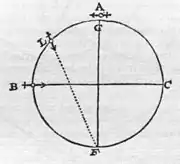CHAP. VI.
On the proportion of declination to latitude[236], and
the cause of it.


The page and line references given in these notes are in all cases first to the Latin edition of 1600, and secondly to the English edition of 1900.
236 ^ Page 196, line 15. Page 196, line 18. De proportione declinationis pro latitudinis ratione.—Gilbert here announces, and proceeds in the next seven pages to develop, the proposition that to each latitude there corresponds a constant dip to a particular number of degrees. If this were accurately so, then a traveller by merely measuring the dip would be able to ascertain, by calculation, by reference to tables, or by aid of some geometrical appliance, the latitude of the place. In this hope Gilbert fought to perfect the dipping-needle; and he also worked out, on pages 199 and 200, an empirical theory, and a diagram. This theory was still further developed by him, and given to Thomas Blundevile (see the Note to p. 240). Briggs of Gresham College, on Gilbert's suggestion, calculated a table of Dip and Latitude on this theory. It was found, however, that the observed facts deviated more or less widely from the theory. Kircher (Magnes, 1643, p. 368) gives a comparative table of the computed and observed values. Further discovery showed the method to be impracticable, and Gilbert's hope remained unfulfilled.
237 ^ Page 197, line 18. Page 197, line 21. progressionis centri.—Note Gilbert's precision of phrase.